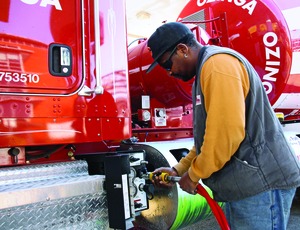

As a transportation fuel, natural gas has a lot to offer: It is cheap, abundant and clean. The downsides: lack of available pumps, less power and a higher up-front cost for the vehicle. These are hard to overlook, but fleets are doing just that in an effort to cut their fueling costs.
Today, natural gas sells for a price equivalent of $1 to $2 per gallon less than diesel. "As we get more filling stations across the country, more and more truck fleets are looking to take advantage of that cost differential," says Bill Boyce, regional sales manager at Cummins Westport, whose model ISL-G engine can run on compressed natural gas (CNG) or liquid natural gas (LNG).
Buses and garbage trucks are the largest markets for CNG in the U.S., but the field is expanding to include construction. Ozinga Bros. Inc., a ready-mixed concrete company in Chicago, last year outfitted what is believed to be the first mixer truck in the Midwest to run on CNG. The Kenworth is equipped with the Cummins Westport 8.9-liter ISL-G, essentially a retrofitted diesel, and two fiberglass saddle tanks that offer the equivalent of 60 gallons of diesel fuel, or enough to get through a day's worth of hauling concrete.
Trucks running natural gas, which is delivered to a spark-ignited engine, need special fuel tanks. Due to the large volume that compressed fuel requires, a CNG truck typically is ideal for local delivery. Fleets tend to use LNG for long hauls. A CNG concrete truck costs about $40,000 more, or 20% more, than a diesel. But it has fewer exhaust maintenance items.
Ozinga likes the energy security, cleanliness and cost savings. "This is something that we feel makes a whole lot of sense," says Marty Ozinga IV, executive vice president. "We're optimistic about it."
The driver is not complaining about the truck's performance, either. "It's got the power," said Albert Arnold, as he took me for a spin late last year near Chicago's Chinatown neighborhood.
Natural gas produces less torque than diesel—our truck was rated at 1,000 lb-ft, about 20% less than a diesel—but its six-speed Allison automatic transmission compensated with boosts of pulling power between shifts. Now, Arnold, a 40-year-old truck driver, refuses to return to a manual shifter. "It's a done deal," he said.
We stopped to fuel up at one of Chicago's few public gas stations equipped with a CNG pump, and I discovered that filling up a CNG truck is easy. Similar to a hydraulic fitting, the pump's brass hose connection snapped right onto the tank's port. Arnold did this with his bare hands, and there were no fumes or drips.


Post a comment to this article
Report Abusive Comment